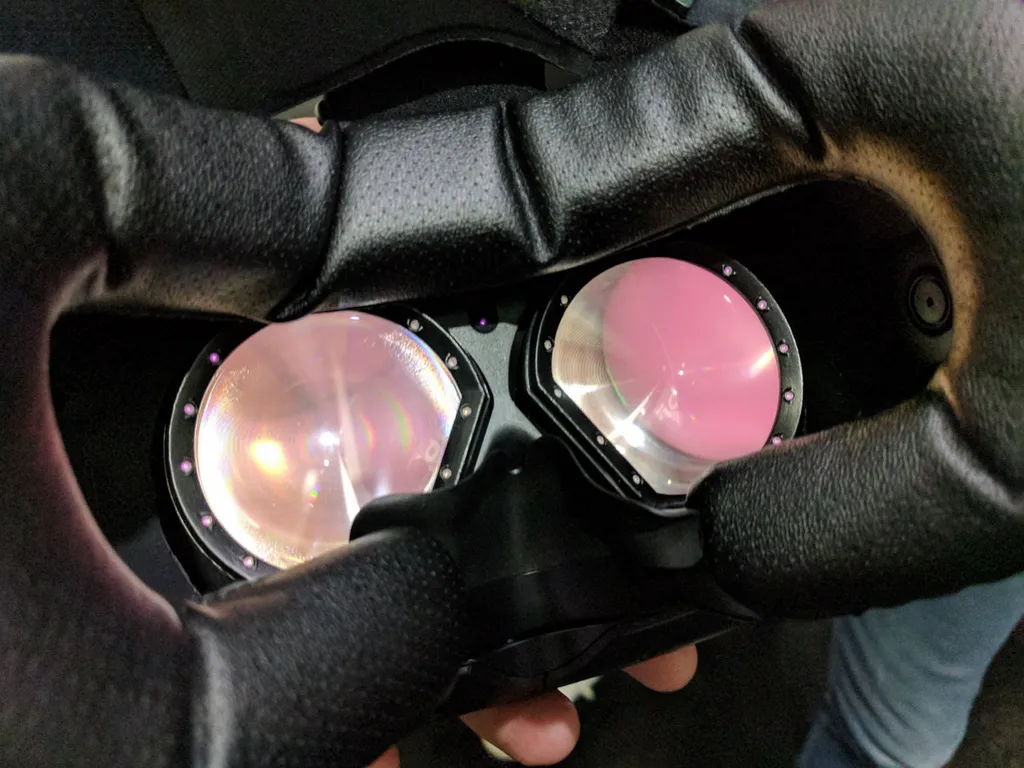At CES last week one of my first demos was with Tobii and its eye-tracking technology. I left the demo convinced that once you’ve tried a VR headset with eye-tracking included you’ll never want to wear one without it again.
Google, Facebook and Apple all purchased eye-tracking companies over the last few years because these tech giants know what benefits are possible with the technology. If you know where a person is pointing their eyes at any given moment you can do things with software interaction and optimization that were never possible before. For example, eye-tracking could allow next generation headsets to dramatically upgrade resolution without adding a ton to rendering cost. That’s by way of foveated rendering — where the greatest detail is only drawn directly in front of your eyes. Manufacturers could even use eye-tracking to measure the distance between your pupils, which could help people maximize the 3D effect seen inside a VR headset just by getting it set up right.
But more important to developers, eye-tracking completely changes the way people interact with a virtual world. Tobii sells a modified HTC Vive with its eye-tracking tech installed and, in a series of demos, I was given the freedom to flip eye-tracking on or off at any time. Not once did I prefer eye-tracking off and it so enhanced the experience of interacting with a virtual world I started disliking the HTC Vive without the feature turned on. Below is a look at the demos I tried, each of which was either more immersive or easier to accomplish than if I had been using a headset without eye-tracking.
Bringing Your Eyes To Life
Making Eye Contact
Better Targeting
Adjusting Controls
Selecting Things
Playing A Game
I was so impressed by these demos and how they enhanced the experience it makes a lot of sense for innovative developers to think about getting a VR headset with eye-tracking so they can start planning now how to take advantage of the technology.
What About The Risk?
I found the benefits of eye-tracking to be so profound that it would be hard for me to imagine anyone turning the feature off once headsets come with the technology embedded. That means when Google, Facebook or Microsoft start shipping headsets with the technology, they could be pretty intrusive in how they choose to use it.
The same feedback loop causing people to prune their friend lists and newsfeeds so they only interact with people and ideas with which they agree could have a far more dramatic effect with eye-tracking. Imagine a spreadsheet stored somewhere that saves how long your eyes stay focused on everything from colors to objects and individuals. It would be possible to build a highly individualized and deeply telling list of everything you like and dislike — including lots of things you may not want shared. And because eye-tracking is so beneficial to the overall experience of wearing a VR headset, tech companies interested in using this data might have a lot of freedom in doing so. In other words — it might be incredibly hard to say no.
Tobii actually said it is prepared for this situation and includes a separate agreement with manufacturers covering the use of gaze data. Manufacturers are required to seek the approval of users before storing their gaze data, according to the eye-tracking company.
“Privacy is a very important aspect of any new technology which is why we require both the software and hardware companies that use our technology to get the explicit (and stand-alone) approval of users if they plan to store or analyze gaze data,” Tobii said in a prepared statement. “It’s also important to know that there are a variety of ways that this data can be used to help improve user experiences (better UIs, automatic settings, etc.), for those users who specifically consent for that information to be used.”
But when nobody reads the terms and conditions, is that going to be a strong enough step to protect people when all VR headsets include this feature?
A number of companies have already been making heat maps based on aggregate and anonymized gaze data produced by recording where everyone’s head is pointed during a VR experience. Here’s an example of such a heat map overlaid on top of a 360-degree video:
Such a heat map is incredibly useful to creators in allowing them to dissect what works and what doesn’t in their projects. And for ad-driven businesses like Facebook and Google, the more they know about you the more effective ad targeting they can provide their customers. With the jump to eye-tracking, though, is the information too detailed? The eye data is so personal a comparable analogy might be your PC manufacturer installing a keylogger or mouse movement tracker to record everything you do on your PC. Would you want anyone — even your family — having access to that kind of unfiltered level of information about you?


























